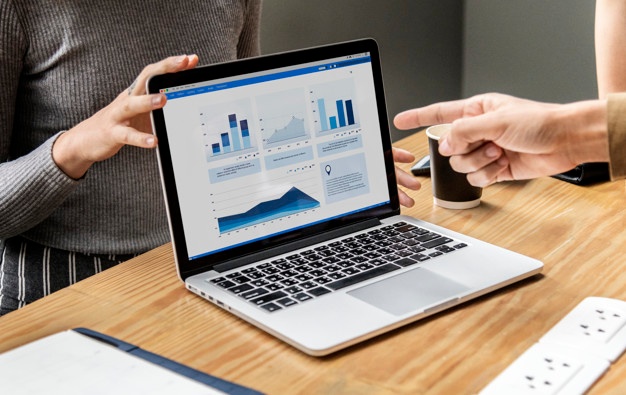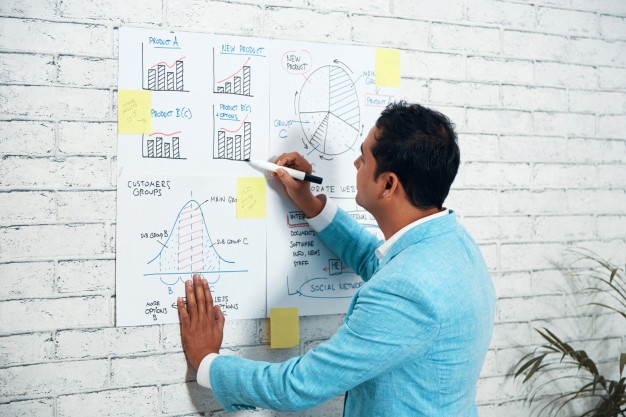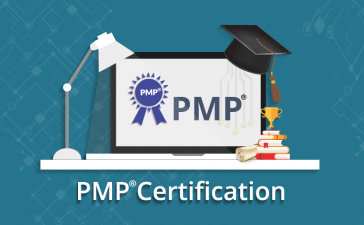We have heard the quote ‘Data speaks if you are willing to listen’. Business analytics are statistical tools that use data and generate new business insights. The role of a business analyst is therefore crucial. The profile of a business analyst is that which is lucrative and strategic. To crack an interview thus is very decisive. Let’s get together and see how the questions can be put forth and how to emerge winners in the business analytics segment.
Basic Questions
1. According to you, what would the role of a business analyst be and its benefits to the organisation?
This is the basic question that is asked to know the readiness of the candidate at the start of the interview. While we all know that a business analyst is that link or bridge between different stakeholders who belong to different domains within the organisation. The benefits to the organisation are simply ironing out and smoothening up the various processes and streamlining them. Thus the project gets executed efficiently.
Your edge: Without sounding formal, you can simply draw a flowchart about how various departments can complete a project by using business analytics

2. Since you are an analyst, how do you analyse your role deemed fit in our organisation?
This question is posed to you to check your preparation for the interview. While you answer it the interviewer comes to know if you gel with the expectation that the organisation has from you as a business analyst. Your answer can be made up of 2 parts, the first talking about your academic excellence and the second about your past professional accomplishments. You can state your academic qualification and then slowly move to professional accomplishments and while at it, keep talking about specific things that you achieved as a business analyst. The answer should sound like a problem followed by a solution type of answer.
Your edge: While highlighting your accomplishments keep in mind to emphasize all those examples or scenarios, which are required and are relevant for this particular job.
3. What should be the core competency of a business analyst for this particular post and organisation?
As individuals are not alike, so is the case with organisations. The ‘one size fits all’ jargon does not fit the role of a business analyst. Though the core requirement like business analytics, problem-solving, and tools knowledge remains the same. What may be different is the approach at the larger level. While answering this question, it is necessary that you have seen and understood the job requirements thoroughly and expectations of the organisation from you.
Your edge: Bring onboard your analytical and tactical solving skills on board citing examples to give you an edge.

4. As a business analyst you may be aware of some tools that are frequently used. Can you name the ones you know and have worked with?
Here they are checking you out on technical as well as non-technical parameters. The technical tools will include the knowledge of Microsoft Office, ERP systems (SAP and its specialties), Google docs, database management tools, SQL, and others. The non-technical aspects will include a documentation system, requirement elicitation technique, and business analysis perspective to name a few.
Your edge: Let your answer be customised for the post and highlight all the skill set that is required for that particular role
5. Can you elaborate on your technical skills? Especially the ERP and SQL ones
Your technical skill set is an asset to the organisation. While Google docs and office skills are mandatory, the added advantage for a business analyst is proficiency in ERP or SQL databases. These improve the prospects of the candidate.
Your edge: talk in-depth about the business analytics tools that you are aware of in-depth and how you have used them in the past.
6. What do you mean by INVEST in business analytics?
While the interviewer does know the full form of INVEST as a short form of independent, Negotiable, Valuable, Estimable, Sized appropriately, and Testable. What is expected out of you is how each aspect is understood by you and how you can use it in a real-time scenario. As a business analyst, you can highlight each aspect in one line and if possible how you have used it as a business analyst.
Your edge: Without bragging, but very assertively, explain to the interviewer that you as a business analyst have sufficient knowledge for this post.
7. We are sure you have heard the terms SWOT and MoSCoW could you elaborate on them?
The above 2 are management tools often used in business analytics, so the recruiter is checking if you are aware of these management tools often used by a business analyst. SWOT stands for Strength, W stands for weakness, O stands for opportunity and T stands for threats. These 4 parameters are used by a business analyst while framing out a solution to organisational risk.
While MoS stands for must or should and CoW stands for could or would. As a business analyst knowing the priorities is necessary to implement strategies and policies.
Your edge: As a business analyst try and highlight this to the recruiter, in case you know more tools used in business analytics

8. Can you throw light on product deliverables?
As a business analyst, it is necessary that the product must be delivered at the right time and right place as promised to the customer. This leads not only to external or internal customer satisfaction but a benchmark that the promise has been met leading to the positive outcome of the project.
Your edge: Business analytics thrives on consistency and timely delivery. Highlight these points to gain an edge in the interview.
9. As a business analyst and with a busy life. Also with the current market scenario and other business factors, how do you keep abreast with the latest trends and knowledge in the marketplace?
Learning never stops, so does innovation. By posing this question the recruiter tries to find out how you keep track of the latest business development trends and tools. With this question, your motivation level is checked, since a market is a dynamic place and businesses tend to change their strategy to match the trends.
Your edge: Attending business conferences helps you know the merging market scenario. In case you have attended one in the recent past, make it a point to highlight it. Also if you have recently upgraded your skillset, do not forget to mention it. This demonstrates your business analytics skills as well as shows how good a business analyst you are.
10. How would you as a business analyst define the stages of a business project?
The flow of any business project is in 5 stages namely starts with project initiation. Once it is initiated next is project planning. A well-planned project then enters the execution phase. Once the project rolls on it require monitoring and control. When all the above stages are completed the last phase is closure. Thus the business project is cited as a success.
Your edge: Bring forth to the recruiter the role you have played in the past in a business project and your role throughout or at a particular level, that ensured successful completion of the project.

Technical and business solving and analysis question
11. You must have heard the term UML, can you explain and state its uses in business analytics?
Unified modeling language (UML) is the language used for general purposes like a developmental language to predict the system. Though used primarily for software development, it sees its use in various segments of the organisation like describing job roles or organisational functions and sometimes business processes. Basically helps eliminate errors and bottlenecks.
Your edge: Drawing a flow chart gives a deep understanding to the recruiter.
12. What is the system requirement specification? Can you elaborate as per your understanding?
This is basically a software requirement. It is a set of documents that describes the features of the software applications that are being used. There were various aspects to the SRS system. They are namely:
- Scope of Work
- Data Model
- Non- functional requirements
- Functional requirements
- Assumptions
- Dependencies
- Constraints
- Acceptance Criteria
Your edge: The model is used across by business analyst so answering innovative descriptions can be an edge.
13. How does BRD differ from SRS? Your views on this?
We are now aware of the SRS system. Explain BRD or the business requirement document in detail.
- While SRS is derived from BRS and BRS is derived after client interaction and client needs.
- BRD is developed after a business analyst knows the client’s needs and requirements after a proper briefing and interaction from the client and for SRS technical expertise like a system architect.
- BRD is a formal document that is verbal and written, which spells the needs of the client. SRS talks about the functional and non-functional aspects of the software
- BRD indicates the high-level functional specifications of the software. SRS in the meanwhile indicates high-level functional as well as technical aspects of the software.
Your edge: As a business analyst complete knowledge of both systems is necessary. Thoroughly brushing up on all tools before the interview is necessary.

14. Can you elaborate on a requirement? How is it different from need?
Requirements would in simple language mean targeted solutions. This will help in achieving the goals or the purpose. Every requirement will necessarily require proper documentation. An example of requirements could be a resume with the educational qualifications that are required for the job of business analyst. You requiring the job is the need.
15. What is the skill a business analyst must have especially at the middle management level?
The skills a business analyst must have are categorised as follows:
- Technical skill
- Fundamental
- Business analysis skills
Technical skills will include software knowledge like SQL, ERP systems (SAP and other areas of business analytics), Google docs, and Microsoft Office to name a few.
Fundamental skills must comprise skills like problem-solving, communication, management, and research skills. Through knowledge is mandatory at middle-level management
Business analysis skills encompass business analytics skills like requirement elicitation, documentation, decision making, creativity, and analytical skills
Your edge: Emphasise these skills and add your touch with examples of the past work that you have done.
16. What are the difficulties a business analyst may face while implementing a project?
A project in any of its 5 phases may run into difficulties. They can be internal issues like employee-related issues or technology or software issues. The difficulties may also be external like policy (ex: change in policies by the government), or errors in the business model. Access-related difficulties may arise too from the client’s side.
Your edge: As a business analyst you thrive on challenges. Specify the challenges you faced and how you played a role in resolving them.
17. As a business analyst how do you perceive the difference between business analysis and business analytics?
The fundamental difference is that the former is more to do with the functional aspect and is process-related whereas the latter is pertinent to data. While doing business analysis a business analyst perceives the business need and subsequently determines the solution to the said problem. In this process, a business analyst uses tools like SWOT, MoSCoW, FIVE WHY to name a few. While in business analytics a business analyst uses the data and analyses it using his acumen while keeping insights of the business. Here too the data is analysed by using tools and techniques like BI or BIG BI to name a few.
Your edge: If you have a thorough knowledge of the tools, showcase them to the recruiter.

18. In business analytics what would the term process design mean?
Business goes through a lot of ups and downs. The challenges can be many, a process design helps the business analyst analyse these challenges that are faced by the business and helps him arrive at a solution that is effective and efficient. Using a process design a business analyst creates a workflow that helps to reach the desired outcome in the shortest period of time.
Your edge: Workflow examples can be shown to explain the term thoroughly.
19. What does GAP analysis mean to you and which types of GAP as a business analyst have you encountered?
As the term suggests GAP means finding the difference between the targeted outcome and the existing performance. GAP can be segregated into 4 types namely as follows:
- Manpower GAP- It is the gap that is generated when the desired number of people required for the completion of the project is far less than the current number of people working on the project. It is deficient in manpower.
- Profit GAP- The difference between the desired profit (target) vis a vis the current profit.
- Product or market GAP- The difference in the budgeted sales and the actual sales.
- Performance GAP- The contrast between the actual and desired (targeted) performance
Your edge: Since the question is related to your expertise, cite examples of only those GAPs that you have come across in your professional journey
20. What is your understanding of a product life cycle?
When a project comes on the desk of a business analyst, in order to understand it and simplify the process he draws a skeletal or a framework chart. This framework helps to split the project into phases that are not only manageable but also show the key decision points throughout the project duration. This means product life cycle. To chalk down this framework many tools like Waterfall, Iterative, Agile or V-shaped models can be used by the business analyst.
Your edge: Pick the model you are comfortable with and explain it in detail.

21. What are the prerequisites to design a use case? What are the best practices to use it?
A use case has to be a compact, distinct, and detailed document. The prerequisites are:
- The first phase is user identification
- The second phase is to capture functional and non-functional data to make the structure
- The final phase is to review and validate the use cases.
The best practices would are as follows:
- The use case has to be standalone
- An alternate flow plan runs parallel to the main flow
- The functional and nonfunctional requirements must be clearly identified and used
- Provide value to the stakeholder
- The use case defines the system and does not describe the design
Business analytics question for upper management level

22. How can an alternate flow be differentiated from an exception flow?
Alternate flow runs parallel to the mail flow. Basically, they are a backup flow in case the main flow fails. An exception flow on the other hand is the flow that is made only when an exception or an error comes in the flow.
23. What does the term Pareto Analysis mean in business analytics?
Popularly also known as the 80:20 rule, Pareto Analysis is a decision-making tool. This tool is important while addressing defect resolution or quality control. The 80:20 rule is derived from the fact that 20% causes the create and 80% is the effect of the create on the system.
24. Explain what a business model analysis means to a business analyst?
When a business is planned, it has to be evaluated on parameters like social impact, economic value, etc. Business Model Analysis thus analyses, whether the business would be profitable and feasible, on these parameters. Using the business model analysis a business analyst draws a blueprint of the business and proposes change or innovation required with the organisation.
25. Requirement traceability matrix – explain this in short.
When a project is planned it is necessary to record the requirements of the client clearly and also ensure that all the criteria or necessities are met. This is the requirement traceability matrix.
26. As a business analyst how do you ensure that you have gathered all the requirements?
Requirement gathering is a huge task and is important for the proper execution of the project. Requirement gathering is taken as completed only when the following information is gathered :
- The information gathered has been seen, approved, and corroborated.
- The requirements are in sync with the business requirements.
- The available resources are sufficient for the requirement.
- All stakeholders are coordinated with the obtained requirements.
27. The business analyst may involve themselves in the implementation of requirements. Your views on the same?
A business analyst has to have complete domain knowledge and providing an analytical solution is sought from them as a professional. When a business analyst involves himself in the implementation of requirements, he can gauge the problems that may arise in the future at the implementation stage. In this scenario, the business analyst can iron out the problem related to business strategy. At an individual level, it can help the business analyst provide solutions in the same case scenario and gain domain knowledge.
28. Evaluate Kanban as a tool?
Kanban is an inventory control system used in JIT and originated from the Japanese term sign. The tool uses a visual medium as a sign to manage and oversee the process. The tool is excellent since it works on signal and response systems. Once any particular item runs low, it sends the signal to stop and in response, the item can be ordered before it is completely exhausted and the work stops.

29. Explain the term ‘increment’?
When a backlog is cleared in a dash it is referred to as increment.
30. Bring forth the differences between incremental and iterative development?
The basic difference is that iterative development software development cycles happen in the sprint and release. While in an incremental model, design, and testing takes place till the product is finished.
FAQs

Carry all the recommendations from organisations and clients this holds more water along with your certifications
A plain shirt tucked into plain pants with a necktie is an ideal combination. You may slide into a coat in case the weather is conducive and the interview id for a post in top or middle management.
Be present at least 30 min before the scheduled interview. This helps to calm down and gauge the mood of the working of the organisation
In case you are offered tea/coffee, you can definitely drink it and it won’t be treated as impolite










I learned a lot of new facts about the Business Analyst interview Q/A through your write-up. This is very useful as well as informative. Do keep posting on topics like this one.
Such a useful blog and i am very impress because it is very helpful for me to crack interview for Business Analyst Interview Questions and Answers department. You Had Done great research for writing this blog.
I am so glad I found an actual article that explains and sticks with the actual topic. Really impressive and I learned a lot from Business Analyst Interview Questions. Great share.
Hi sir, I am interested in business analyst certification n want detailed information about it.
The interview questions and answers featured in this article offer practical guidance for business analysts. It covers topics like process improvement, documentation, and data modeling. An excellent resource to enhance your preparation for a business analyst interview.
This article on business analyst interview questions and answers is a valuable resource. It provides concise yet comprehensive information, covering key areas like problem-solving, communication skills, and data analysis. A must-read for anyone preparing for a business analyst interview.